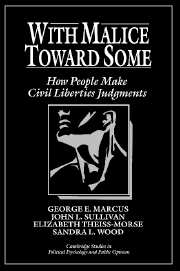Book contents
- Frontmatter
- Contents
- List of Figures and Tables
- Preface: Political Tolerance and Democratic Life
- PART I Theoretical Background and Overview
- PART II Contemporary Information and Political Tolerance Judgments
- 4 Tolerance Judgments and Contemporary Information – The Basic Studies
- PART III Refining the Model – The Role of Antecedent Considerations as Individual Differences
- PART IV Implications and Conclusions
- Appendix A: Hypothetical Group Scenarios and Manipulations
- Appendix B: Methodological Approaches and Scales
- Notes
- References
- Index
4 - Tolerance Judgments and Contemporary Information – The Basic Studies
Published online by Cambridge University Press: 05 August 2012
- Frontmatter
- Contents
- List of Figures and Tables
- Preface: Political Tolerance and Democratic Life
- PART I Theoretical Background and Overview
- PART II Contemporary Information and Political Tolerance Judgments
- 4 Tolerance Judgments and Contemporary Information – The Basic Studies
- PART III Refining the Model – The Role of Antecedent Considerations as Individual Differences
- PART IV Implications and Conclusions
- Appendix A: Hypothetical Group Scenarios and Manipulations
- Appendix B: Methodological Approaches and Scales
- Notes
- References
- Index
Summary
People react with their guts instead of their head and then justify intellectually what their gut reactions are. Guts have nothing to do with this.… If guts decided what kind of Bill of Rights we were going to have,… we'd have a very different country. We'd probably have something closer to a dictatorship.
David Goldberger, “Skokie: Rights or Wrong”We have thus far laid out the basic arguments that constitute the foundation for our model of tolerance judgments. First, as Chapter 2 revealed, previous research has clearly established the strong influence of antecedent considerations, such as personality, education, and commitment to democratic principles, on people's current tolerance judgments. Such predispositions and standing decisions presumably set boundaries on people's willingness to be tolerant or intolerant at any given time. But this past research also identifies another potential influence on tolerance: perceptions of threat. While people may have a predisposition to see threat as pervasive, or a standing decision to perceive a disliked group as threatening, threatening stimuli in the environment can also be especially relevant pieces of contemporary information.
As we discussed in Chapter 3, Gray argues that the BIS monitors the environment for threatening stimuli that violate norms of proper, orderly behavior. Therefore, the type and degree of threat a group poses provide people with information that may affect their current tolerance judgment. State of mind, that is, whether people pay attention to their thoughts or feelings, may also affect their contemporary tolerance judgments.
- Type
- Chapter
- Information
- With Malice toward SomeHow People Make Civil Liberties Judgments, pp. 55 - 98Publisher: Cambridge University PressPrint publication year: 1995

